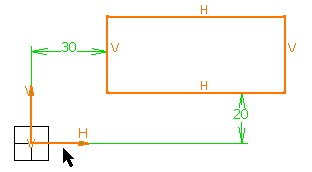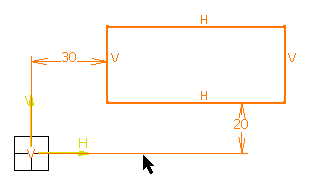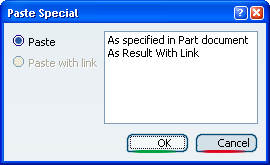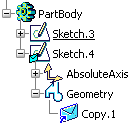Copy/Paste Elements with H and V Constraints on Their Absolute Axis
You can copy/paste elements along with the horizontal and vertical constraints on their absolute axis.
To duplicate the rectangle and its H and V directions: multi-select
the rectangle and its origin, and copy the selected elements.

To duplicate the rectangle, its H and V directions, and the
distance constraints which exist between the rectangle and its
origin: multi-select the rectangle and the distance constraints (do
not select the origin), and copy the selected elements.

Paste these elements.
The elements are pasted over the elements you copied. You can move
the pasted elements (if you want to view them, for example).

Copy/paste Projected or Intersected Elements
If you copy/paste projected or intersected elements, then the external references are deleted.
Copy the projected or the intersected element, using the method
described above.
Paste this element.
- External references are deleted.
- Constraints on external geometry are deleted.
- Projections/Intersections are deactivated when they have external
references.
- You cannot project or intersect the pasted element.
- The pasted element is not associative.

Copy/Paste Sketches
To copy/ paste sketch maintaining the associativity between the reference geometry, use the As Result With Link option in the Paste Special dialog box.
Create a sketch then enter Part Design workbench.
Right-click the sketch and select Copy.
Right-click the sketch and select Paste Special .
Select As Result With Link in the dialog box which
appears.

Click OK to validate your choice. The sketch is pasted. A blue envelope is added to the image of the
sketch in the specification tree, meaning that associativity is maintained
between the reference geometry and the copy. Note:
The blue envelope added to the image of the copied sketch
only means that the sketch is a copy As Result With Link. The
information about the state of the links is carried by the Copy.xxx
symbol.

Use this copied sketch to create a pad. Just edit the reference sketch the way you want: for example,
change the shape. The pad reflects the change.
|